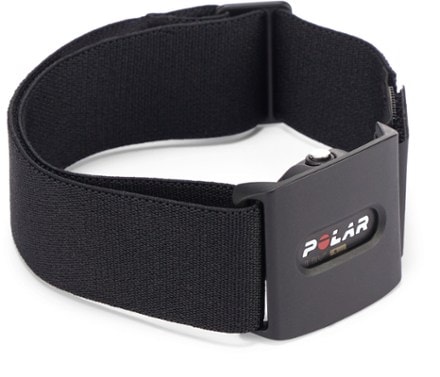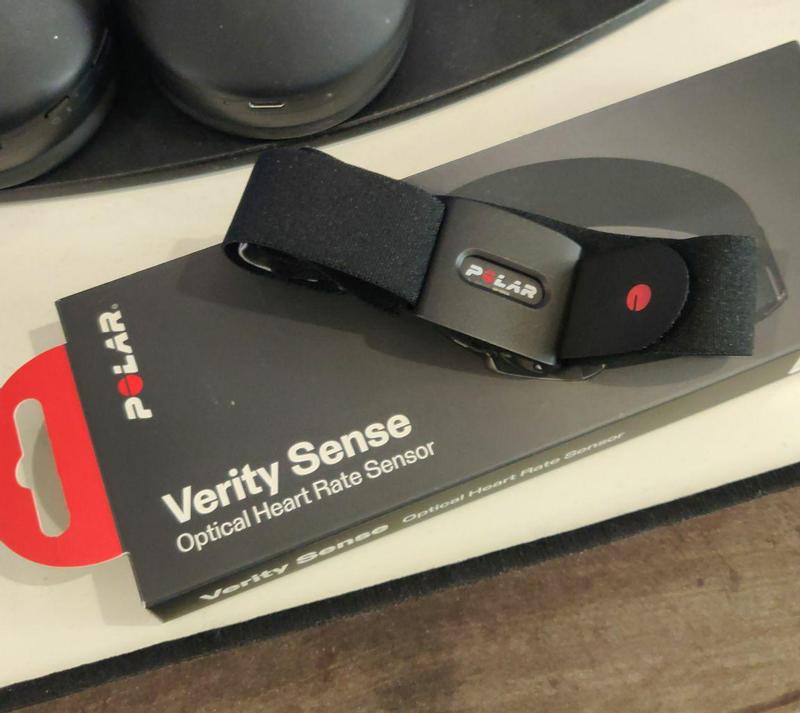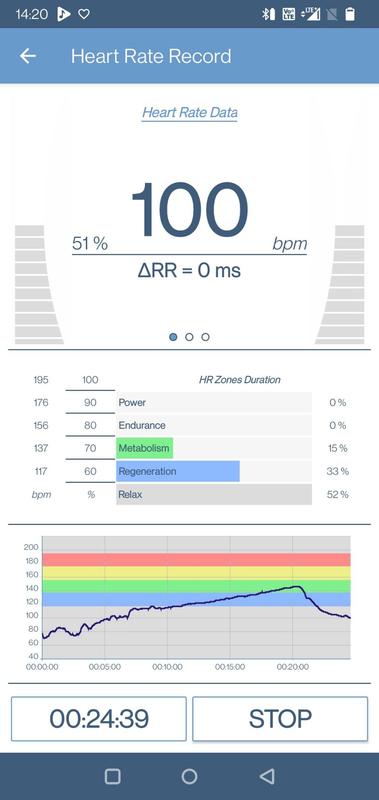Polar Verity Sense Optical Heart Rate Sensor
Built to provide maximum freedom of movement and multiple viewing and recording options, the Polar Verity Sense optical heart rate monitor is a versatile tool for recording your workout data.




This purchase pays for membership!
$10
10% Reward
on this and every eligible full-price item*
+
$30
Bonus Card
valid for 60 days after joining*
=
$40
Value
Keep shopping
- Comfortable textile armband fits snugly and discreetly around your arm; soft textile material is machine washable for everyday use; sensor holder is detachable
- Swimming goggle strap clip holds the Verity Sense snug against your temple for greater comfort when tracking heart rate, pace and distance during pool swimming workouts
- Tracks your heart rate with the high-quality Polar 6-LED optical heart rate solution
- Multiple connectivity options let you send your heart rate to any Bluetooth and ANT+ compatible app, watch or gym equipment and follow your heart rate in real time
- Built-in memory stores up to 600 hrs. of training data; sync your stored data to Polar Flow for analysis
- Broadcast range of up to 150 m in its holder; up to 40 m without the holder
Imported.
View all Polar Heart Rate Monitors| Best Use | Fitness Swimming |
|---|---|
| Average Battery Life | 20 hours |
| Battery Type | Lithium Polymer |
| Illumination | None |
| Altimeter | No |
| HRM Included/Integrated | Yes |
| Heart Rate Sensor Type | Arm |
| Water-Resistant Depth | 50 meters |
| Pool Lap Recognition | Yes |
| Data Exchange | Bluetooth ANT+ |
| Compatible Fitness Accessories | Heart Rate Monitor |
| Gender | Unisex |
Review this Product
Adding a review will require a valid email for verification
Most Helpful Favorable Review
Most Helpful Critical Review
Customer Images
good device, bad software, horrible data grab
The HRM works well, is accurate, and comfortable to wear. However, the setup instructions require you to create a polar account (PC or phone) and give permission to an insane amount of data collection (identity, location, health, etc.). On top of that setup failed as I never received the one time code (email or phone). The only thing that stopped me from returning it was the (free, no-adds) "Heart Rate Monitor" app from BM Innovations. It paired with the Polar right away and is fully offline (no account, nothing ever transmitted).
Great for use w/ rowing machine
This is my first HR monitor. I like that it fits on the arm. I was not interested in a chest strap version. That and a bra - one too many straps. I purchased the Polar Verity to monitor my HR while working out on a Concept2 (C2) rowing machine. It works great. After charging the HR monitor and strapping it on my arm I was able to easily connect it to the C2 PM5 (via BT). I have the C2 Ergdata app on my phone, which I also connect to the PM5 (via BT), and it is reading my HR, so now my heart rate data is logged with each workout session to my C2 logbook account. I created a Polar account on my laptop (to check for any firmware updates) but I don't have the Polar Flow app on my phone. For now I am content to monitor my HR while rowing and using the PM5 and C2 ErgData app.
Best HR Strap I've Used! A game-changer!
The Polar Verity Sense arm HR strap is superb. I have been using it nearly every day for a few weeks now, and it has replaced the three chest HR straps I had rotated using before. The Polar Verity was easy to set up using both my computer and phone app. It attaches to both over BlueTooth, though the plug-in process was easiest. The accuracy is superb: I have compared it to all of my chest HR straps and it is spot-on. I love that I can use the Polar arm strap while swimming – it includes a special attachment for attaching it to a goggle strap (who knew?!). Perhaps best of all, the arm strap is so much more comfortable than chest straps. I have been using heart-rate monitors with chest and wrist straps for over 20 years, since I was a competitive D1 athlete in college, and this is the best strap I have ever used in that time – a true "game changer"! It is also compatible with all of my devices – both Polar brand and non-Polar brand that use ANT+ and BlueTooth. I am very happy with this strap and highly recommend it!
Works for martial arts
I bought this to wear on my upper arm under a Gi during martial arts workouts which don't allow me to wear my Garmin Instinct. Works great. Easily pairs with the instinct and broadcasts across the studio to where my watch is. I've also started using it for HIIT workouts as it seems to be more responsive and accurate. It's comfortable, lightweight, and simple. Recommended.
Good alternative to a chest-strap HRM
More comfortable and more convenient than a chest-strap HRM, and much more accurate my Garmin Forerunner's built-in wrist HRM. I did a side-by-side test using a third-party app that connects the Forerunner to dual external HRMs. Results were impressive. The Verity matched the chest-strap HRM to within 1 or 2 bpm throughout a two-hour run, whereas the wrist HRM was sometimes off by as much as 20 bpm. There were occasional lags of a few seconds when my HR was changing rapidly, but for long runs that doesn't concern me. No problems connecting the Verity to the Forerunner. The elastic strap was comfortable yet secure when worn on my upper arm. No slippage during long runs, unlike the chest-strap. My only complaint is the Polar Flow mobile app. It's supposed to display the Verity's battery level, but I couldn't get it work properly. Not a big deal since the Verity has a colored LED that shows the battery level when charging.
fantastic multi-sports arm HR band
After dealing with some chafing issues with a chest HRM, I switched to this for the majority of runs and rides. If you need super accurate data, this thing gets pretty close. No more HR drift or cadence lock on runs. Much comfier than the full chest strap. The only thing you should know is that optical HR has a 2-4 second lag behind a chest HRM. For sprint work, I prefer the chest HRM, but for steady work / long intervals, I pick this every time. Charging is easy and the battery lasts quite a while. I have to charge every 10 days or so (daily use).
Best optical heart rate monitor
I wear it around my upper arm. Use it for running, hiking, and soccer. Preferred heart rate monitor over the other straps and one optical sensor I have. Chest straps are more uncomfortable, especially when dripping with sweat. During soccer, I've had soccer balls hit the chest strap and sensor. Also, chest straps don't work well for me in cold dry weather.
Surprisingly great!
Pairs directly with Strava, so I don’t need to monkey around with integrating a proprietary app. Lightweight, extremely comfortable, no subscription fee. Great alternative to a smart watch.
Call it the Polar DJ
Call it the Polar “DJ” ‘cause it’s great at dropping beats. But not in a good way. Unfortunately I would not recommend the Verity. I’m a former elite-level rower and I’ve been relying on heartrate-based training since back in the era of the clunky Protrainer XT model. Today I cling to my glory days and try to fight the onset of my Dad Bod by doing a mix of the rowing machine, ski erg, biking, weight training, and a little swimming—and I still pretend that I need all the gadgets to give me the same data I used to rely on back when I was fast. All that to say, I’ve used a lot of heart rate devices, I’m super in tune with my heart, and I have a good understanding of what’s important in a device like the Verity. The reason I was so excited about the Verity optical sensor was that I heard whisperings that it was the first optical device that might be considered the new “gold standard.” That is, it was at least AS accurate as the chest-based straps that up to this point have been considered the gold standard in monitoring. Alas, this optical monitor is not anywhere close. It would have been great to get away from chest-based straps because two things really annoy me about chest straps, and I was interested in the Verity because it would have solved both problems: 1. On chest straps like my H10 and H7, the battery is not rechargeable. Sure, you can replace it in a few minutes and it shouldn’t be too expensive, but it seemed like the battery was always dead at the worst possible moment, like 5:30 in the morning when you’re trying to sneak in some precious time training before you are thrust into Dadworld (pink pancakes with rainbow sprinkles)—and instead you’re burning valuable minutes scrounging around in the junk drawer trying to find a CR2025, only to find you don’t have any left so you go to the drug store to buy one for like $17 instead of getting the 10-pack for $7 at the big box store like a rational, well balanced person would do. Also, it’s not good for the environment to be throwing away that many batteries. The Verity would solve this because it has a rechargeable battery that supposedly lasts for 30 hours (it doesn’t seem to last that long, by the way—and I’ll get to that). 2. The new soft chest straps just end up costing me a lot of money because they start cracking and degrading after six months plus one day. How do I know this? Because the warranty on these straps is exactly 6 months, and every time they fail, they’re no longer under warranty so you have to shell out like $20-30 bucks for a new one. I’m kinda sick of feeling like I should have a subscription to soft straps, and the Verity would have solved this problem because there’s nothing really to break down other than the elastic on the band. I wonder if Polar actually strategically uses delicate materials on the soft straps so that they can make the soft strap a “consumable” device and treat it like recurring revenue, like how a software company now sells annual subscriptions instead of selling a license on a CD. OK. All that said, here’s why my dreams of a brighter future were dashed. First, accuracy. A heart rate monitor is literally useless if it’s not accurate. The Verity is about as useful as having a clock that you’re not sure is 10 minutes fast or 10 minutes slow, and might be either/or depending on the day. I think part of this problem is connectivity, and part of it is the “smoothing” algorithm that they must be using under the hood. Either way, none of the troubleshooting steps I took seemed to solve the issue. It’s still not accurate. Examples: when I’m in the middle of a steady-state workout where I know my heart rate will not deviate more than 5 beats up or down from 140, the Verity will inexplicably start showing something like 120-130 bpm. Sometimes it’s not off enough that it would be noticeable to most people—like 10 or 20 beats doesn’t sound like a lot—but 10-20 beats is like 1,000 miles if you are serious enough about training to use a heart rate monitor. At other times, the difference is just laughable—like it will dramatically drop to 75 beats per minute when I’m 20 minutes into a hard 10k and my real heart rate is closer to 170. I can’t find any rhyme or reason to this (initially I thought maybe the real value was divided by 2 or something? Or maybe it only happened when the band was on a hairy part of my arm instead of a smooth part?). I also tried it on different parts of my body, like my ankle instead of my arm. Problems persisted, no matter what I tried. The other thing that happens is that whatever “smoothing” algorithm they use gives you noticeably incorrect values if you’re doing shorter interval work. It might work better for you if you generally do long steady state workouts where your heart rate is not changing very much, but with intervals here’s what happens: Rather than giving you your actual heart rate, it seems to give you some kind of average heart rate of the previous 10-20-ish seconds blended together. So for example when you’re towards the end of a three minute hard interval and you decide to sprint for the last 40 seconds to get your heart rate quickly climbing up close to its max, you’re readout doesn’t show your instantaneous heart rate at the end. Instead it seems to lag behind the real heart rate and show some kind of lower value that is a blended average. Example: my max is about 194 and when I wear a chest strap it will show 194 on the scenario I described above, but with the Verity it might show something in the 180s. The is the first device in 20 years I’ve ever used that shows an INCREASE in heart rate after I’ve completed a hard interval. Never have I seen that, even with multi-point EKG treadmill tests and VO2 max tests. All these problems are definitely exacerbated if you move around a lot as a function of the exercise itself. For example, the accuracy on the bike is not quite as bad because my arm stays relatively still in the aero bars or on the handle bars (but I do still get accuracy problems on the bike), whereas when I’m on the rowing machine or ski erg and my arms are actively involved in the motion, I completely removed the monitor in multiple workouts because the issues were so frustrating. The other issues seem to be buggy things. Like multiple mornings my watch (the Polar Vantage) was saying it could not connect with the Verity sensor because the Verity battery was low. This definitely wasn’t the case (if the 30 hour battery life statement is true), because a) I had just charged it and b) my ANT+ bike monitor had no problem connecting to the Verity for the entire 80-minute workout (I usually simultaneously connect my strap to 2 devices—my watch, so that I can download my data, and my monitor on the machine, so that I can easily see my heart rate on the screen with the rest of the data). I can’t help but wonder if Polar is pulling the same trick on us here that they did with the Vantage watch: they knowingly release a device that was not ready for prime time, basically still in beta and laden with bugs and lacking table stakes functionality, then they spend a year and a half getting it close to the point that that it should have been in the first place to confidently release it, then they tell you they are no longer going to support the device after you’ve gone through that year and a half of annoyances so now you should buy the next version. Other feedback that might be helpful if you’re a swimmer or if you use the Polar Flow app: Gold standard? If you have any other doubts as to whether this device can compete as a gold standard: it is not compatible with Polar’s “orthostatic test” that they provide as a recovery measure within their Flow app. That is, you must wear a chest-based sensor like the H10 to perform the test, and it won’t even start the test if you are wearing the Verity. Not sure why this is, but to me it suggests that something is inferior with the Verity when it comes to providing data.
Works as Advertised
I use this to connect to the equipment I use in the gym. The connecton is flawless, and my pulse is constantly displayed on the face of the treadmill or whatever device I'm using.






